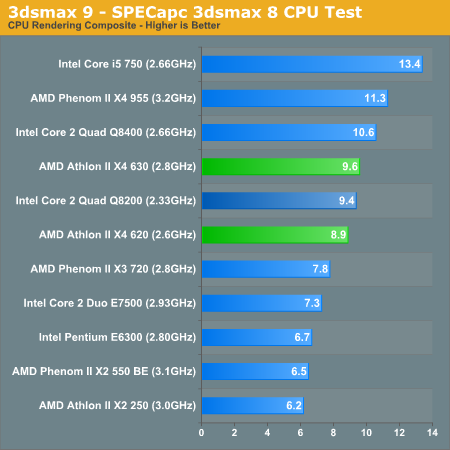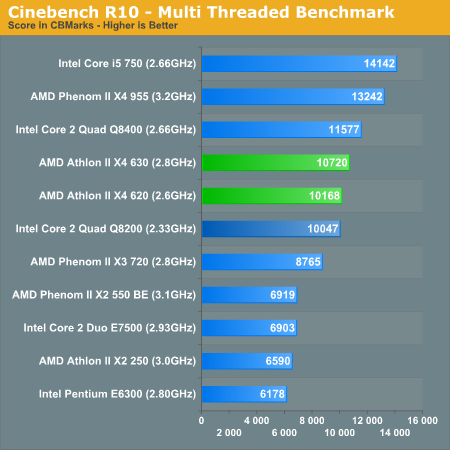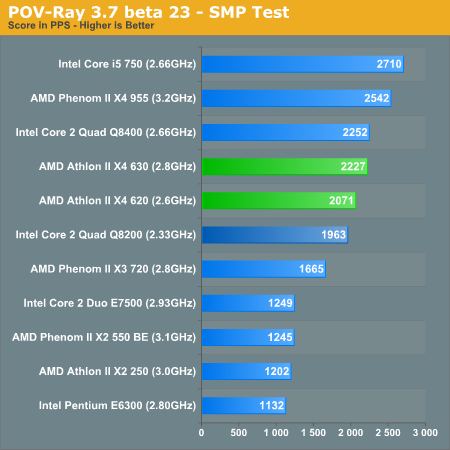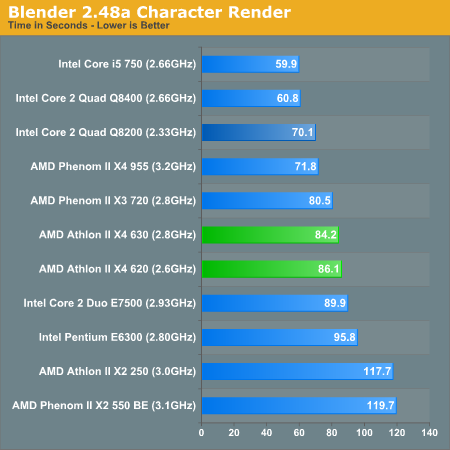AMD Athlon II X4 620 & 630: The First $99 Quad Core CPU
by Anand Lal Shimpi on September 16, 2009 12:00 AM EST- Posted in
- CPUs
3dsmax 9 - SPECapc 3dsmax CPU Rendering Test
Today's desktop processors are more than fast enough to do professional level 3D rendering at home. To look at performance under 3dsmax we ran the SPECapc 3dsmax 8 benchmark (only the CPU rendering tests) under 3dsmax 9 SP1. The results reported are the rendering composite scores:

Offline 3D rendering should be another safe haven for the Athlon II X4. Core count matters and that's what AMD delivers. At $25 per core the Athlon II X4 620 is faster than even the X3 720. It's of course faster than any dual-core CPU in its price range, including the more expensive E7500. Intel's Core 2 Quad Q8200 is around 6% faster but costs 60% more.
Cinebench R10
Created by the Cinema 4D folks we have Cinebench, a popular 3D rendering benchmark that gives us both single and multi-threaded 3D rendering results.

Single threaded performance is where the Athlon II X4 suffers the most. It's competitive but still slower than cheaper dual-core CPUs. This is the classic trade off for all pre-Lynnfield quad-core CPUs, you give up single threaded performance for multi-threaded performance. Luckily for AMD, Intel's Core 2 Quads suffer the same fate. While the Athlon IIs find themselves at the bottom of this chart, the Q8200 is the slowest chip here.

Turn up the thread count and the Athlon II shines once more. Again, the 620 is about the same speed as the Q8200, but slower than the Q8400. Just where it needs to be.
POV-Ray 3.73 beta 23 Ray Tracing Performance
POV-Ray is a popular, open-source raytracing application that also doubles as a great tool to measure CPU floating point performance.
I ran the SMP benchmark in beta 23 of POV-Ray 3.73. The numbers reported are the final score in pixels per second.

At this point I couldn't write a more competitive position for AMD. The Athlon II X4 continues to do very well in our 3D rendering tests.
Blender 2.48a
Blender is an open source 3D modeling application. Our benchmark here simply times how long it takes to render a character that comes with the application.

Our Blender test has traditionally favored Intel architectures, and here we see the first signs of the Athlon II X4 not being able to keep up. The Phenom II X3 720 and Core 2 Quad Q8200 are both faster, but compared to Intel's similarly priced dual-core offerings AMD is still quicker.










150 Comments
View All Comments
Chlorus - Wednesday, September 16, 2009 - link
He posted right after me...I'm kinda wondering if we should setup a drinking game or something each time he posts.strikeback03 - Wednesday, September 16, 2009 - link
Good idea, and everyone drinks when you spot a new alias.deputc26 - Wednesday, September 16, 2009 - link
I would absolutely love to see a die size comparison. That will give real information on how this chip can make AMD $$.Lokinhow - Wednesday, September 16, 2009 - link
there is a die size comparsion on the first page..P2 X4 = 258 mm2
A2 X4 = 169 mm2
A2 X2 = 117 mm2
C2Q 8xxx = 164 mm2
deputc26 - Wednesday, September 16, 2009 - link
Apparently I'm a moron. Don't know how I missed that unless it was added after initial publication as I read it right after it came out.Eeqmcsq - Wednesday, September 16, 2009 - link
Anand, how did you know whether or not your Athlon II X4s are harvested Denebs?Also, any idea why the Athon II X4s debut at such a high TDP with no L3? I'd think they'd be lower at 65w or at least 80w.
AMD, $100 quad cores is nice... BUT... where's the 45w quads???
Lokinhow - Wednesday, September 16, 2009 - link
I may be wrong, but..I think the high TDP is because we have both Propus and Deneb-Harvested Cores
The Athlon II based on Deneb probably have this 95W TDP, while the ones based on propus core have lower TDP.
I think they have only a few propus core to sell, so that's why they are selling harvesteds Denebs. When there wil have only Athlons II X4 propous based they'll rate it with a lower TDP.
Makes sense?
Spoelie - Wednesday, September 16, 2009 - link
Yes and noIt's a bit strange that the deneb die (630) consumes less power than the propus die (620) in idle if that theory was valid. During load the difference is just as much as the difference in clock speed would indicate. So if the 630 is indeed a deneb (care to rip the IHS of? ;)) then this means that propus is not by definition less power hungry than deneb.
Anand Lal Shimpi - Wednesday, September 16, 2009 - link
AMD specifically told us that our 620s are Propus samples, but that others may be Denebs. I'm not sure how to tell if you have a harvested Deneb just yet.Give AMD some time, I'm sure we'll see them down below 95W as the process matures for these dice.
Take care,
Anand
TA152H - Wednesday, September 16, 2009 - link
Anand,A couple of things. You mentioned the 'small' L2 cache being a problem on one of your benchmarks, but, it's actually twice as large as the one on the Phenom. I'm not sure if this was meant to be a comparison only with the Penryns, but it's a bit confusing.
Also, going back to the L2 cache, how can these possibly be harvested from Phenoms with a bad L3 cache. That would imply the Phenoms are built with 512K L2 cache, with half of it disabled. I really doubt this is the case. You CAN remove the L3, but how do they then double the L2 cache? This seems strange to me.
Based on the relatively poor overclocking potential of this chip, would you attribute that to the L2 cache? Does the L2 cache run with the same number of wait states as that of the Phenom? If so, that could prove to be the main reason for the lower overclocking potential. Any ideas on this?
Also, don't you think it's worth mentioning AMD's greatly superior IGPs, considering this product could easily find it's way in this platform rather often. The processor by itself does make sense, but, even if it didn't, the superior IGP platform still can make AMD processors somewhat attractive.